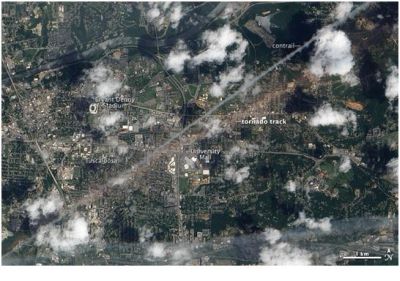
An image by NASA’s EO-1 satellite, showing destruction caused by a powerful tornado, which ripped through Tuscaloosa, Alabama, USA
Credit: NASA Earth Observatory image created by Jesse Allen and Robert Simmon, using EO-1 ALI data provided courtesy of the NASA EO-1 team.
On 27 April 2011, a violent tornado swirled through Tuscaloosa, Alabama, USA. The storm packed winds of 310 km/h, and left a path of debris extending southwest to northeast. On 2 May 2011, NASA’s Earth Observing-1 (EO-1) satellite captured this natural-color image of the tornado track through Tuscaloosa.
In the image, the tan-toned, debris-filled path passes through the center of Tuscaloosa, affecting properties. Running roughly parallel to the tornado track is a contrail from a plane. (A contrail is a type of clouds, induced by the exhaust of aircraft engines.) The mayor of Tuscaloosa estimated the cost of removing the debris to be over $70m.
The US National Oceanic and Atmospheric Administration (NOAA) reported that the tornado was spawned by a supercell thunderstorm, the strongest of all thunderstorm types, which lasted more than seven hours. The supercell started in Newton County, Mississippi, at 2:54 p.m. (local time), and finally ended in Macon County, North Carolina, at 10:18 p.m. (local time). The trail of damage measured 129.2 km long and as much as 2.4 km wide.
Between 25 April and 29 April, a total of 362 tornadoes struck the southeastern and central United States, according to NOAA. The tornado that passed through Tuscaloosa caused more than 1,000 injuries and at least 65 deaths, across several towns and cities. This is the highest death toll from a single tornado, in the United States, since 25 May 1955, when a powerful tornado caused 82 fatalities, in Udall, Kansas.
References
NASA
www.nasa.gov/
NASA Earth Observatory
http://earthobservatory.nasa.gov/IOTD/view.php?id=50434
Wikipedia